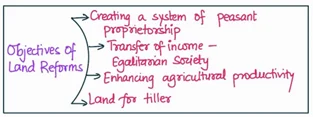Answer:
| Approach:
Introduction
- Give a brief about land reforms.
Body
- Give pointers on how land reforms helped improve the socio-economic conditions of small and marginal farmers specifically. Also mention how it was not fully able to achieve these objectives.
Conclusion
- Conclude saying that land reforms did give some results in the initial period but now it has stagnated and new reforms must come through for achieving its true objectives.
|
Introduction:
Land reform refers to efforts to reform ownership, operation, leasing, sales, and property rights of land in India. The Indian Government was committed to land reforms and to ensure distributive justice as was promised during the freedom struggle. Post Independent India has seen movements like Bhoodan and Gramdan which were persuasive in nature. Later, laws were passed by Governments for abolishing landlordism, distributing land through imposition of ceilings, protection of tenants and consolidation of land-holdings.

Body:
The small and marginal farmers are one of the weakest sections of Indian society and land reforms were seen as a method to reduce their misery. Land reforms helped to improve the socio-economic conditions of marginal and small farmers in the following ways:
- Abolition of Intermediaries: It included abolition of Zamindari, Ryotwari and Mahalwari systems. This led to weakening of the debt trap spun by intermediaries which led to dispossession of land for small farmers.
- Land ownership gave the small farmers greater access to credit facilities.
- Tenancy Reform: It ensured Rent Regulation, Security of land tenure and conferment of ownership rights on tenants. This helped in enhancing food security and investment in irrigation seeds and fertilizers.
- Example: Operation Barga benefited 14 lakh sharecroppers in West Bengal
- Ceiling on Landholdings: Ceiling laws ensured redistribution of land from big landlords to landless laborers ensuring land ownership, access to credit, food security etc.
- Cooperative Farming: Farmers pooled their resources and distributed the income as per their share. This reduced input cost, allowed scaling of cultivation and access to large credit while minimizing risk in case of crop failure.
- Land Records: The updation and now the Digitization of Land Records helps in reducing litigation, security for land owners in case of opting for tenancy, better credit availability to small farmers and better policy making for agriculture. (e.g. Digital India Land Records Modernization Programme (DILRMP)).
However, certain challenges remain with Land reforms:
- Under Land Ceiling, Benami transactions ensured control of landlords over the lands.
- Land consolidation has been a lengthy and cumbersome process due to many cases of litigation. The inheritance laws led to further division and fragmentation thereby reducing the land-holding size.
Conclusion:
Thus, Land Reforms have been a mixed experience with right intention but ineffective implementation. With land availability at 0.12 per-capita, India should now move towards the second generation of land reforms focused on digitization and financial inclusion. New and innovative land reform measures should be adopted with new vigour to eradicate rural poverty and improve the socio-economic conditions of marginal and small farmers
